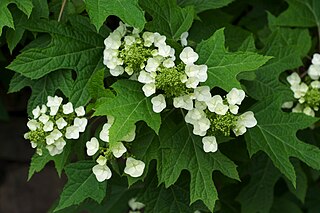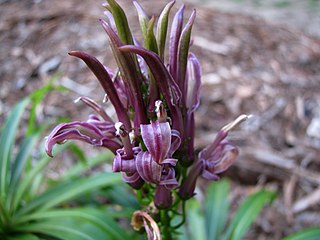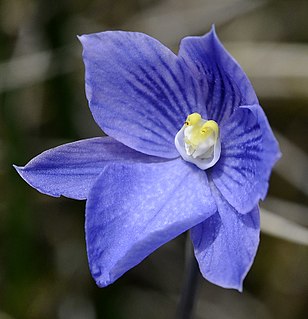
Hydrangea quercifolia, commonly known as oakleaf hydrangea or oak-leaved hydrangea, is a species of flowering plant in the family Hydrangeaceae. It is native to the southeastern United States, in woodland habitats from North Carolina west to Tennessee, and south to Florida and Louisiana. A deciduous shrub with white showy flower heads, it is grown as a garden plant, with numerous cultivars available commercially.

The Hawaiian lobelioids are a group of flowering plants in the bellflower family, Campanulaceae, subfamily Lobelioideae, all of which are endemic to the Hawaiian Islands. This is the largest plant radiation in the Hawaiian Islands, and indeed the largest on any island archipelago, with over 125 species. The six genera involved can be broadly separated based on growth habit: Clermontia are typically branched shrubs or small trees, up to 7 metres (23 ft) tall, with fleshy fruits; Cyanea and Delissea are typically unbranched or branching only at the base, with a cluster of relatively broad leaves at the apex and fleshy fruits; Lobelia and Trematolobelia have long thin leaves down a single, non-woody stem and capsular fruits with wind-dispersed seeds; and the peculiar Brighamia have a short, thick stem with a dense cluster of broad leaves, elongate white flowers, and capsular fruits. The relationships among the genera and sections remains unsettled as of April 2022.

The fraternal myotis is a species of vesper bat native to East Asia.

Cyanea is a genus of flowering plants in the family Campanulaceae. The name Cyanea in Hawaiian is hāhā. These Hawaiian lobelioids are endemic to Hawaii with over 90% of Cyanea species are found only on one island in the Hawaiian chain. They grow in moist and wet forest habitat and are largely pollinated by birds such as the Hawaiian honeycreepers, and the seeds are dispersed by birds that take the fruits. Most Cyanea are trees with few branches or none. The inflorescence is a raceme of 4 to 45 flowers which grows from the leaf axils. The fruit is a fleshy berry. There have been several theories regarding the evolution of large prickles on plants endemic to islands that lack any mammalian or reptilian herbivores. One such theory suggests that the prickles are a defense against herbivory by the moa-nalo, a few taxa of flightless ducks that went extinct on the islands within the last 1600 years.
Cyanea acuminata is a rare species of flowering plant known by the common names Honolulu cyanea. It is endemic to Oahu, where there are no more than 250 individuals remaining. It is a federally listed endangered species of the United States. Like other Cyanea it is known as haha in Hawaiian.

Cyanea asarifolia is a rare species of flowering plant in the bellflower family known by the common name gingerleaf cyanea. It is endemic to Kauai, where there were no more than 30 individuals in a single population as of 2005. It is a federally listed endangered species of the United States. Like other Cyanea it is known as haha in Hawaiian.
Cyanea copelandii is a rare species of flowering plant in the bellflower family known by the common name treetrunk cyanea. It is endemic to Maui, where there are no more than 250 individuals remaining in the wild. It is a federally listed endangered species of the United States. Like other Cyanea it is known as hāhā in Hawaiian.
Cyanea dunbariae is a rare species of flowering plant in the bellflower family known by the common name ravine cyanea. It is endemic to Molokai, where there were sixteen plants remaining in the wild as of 2005. It is a federally listed endangered species of the United States. Like other Cyanea it is known as haha in Hawaiian.
Cyanea eleeleensis was a rare species of flowering plant in the bellflower family known by the common name Eleele cyanea. It was endemic to Kauai, where it has been declared extinct. It was federally listed as a critically endangered species of the United States in 2010. Like other Cyanea it is known as haha in Hawaiian.

Cyanea grimesiana is a rare species of flowering plant in the bellflower family known by the common name splitleaf cyanea. It is native to Oahu and Molokai, where it is known from 12 occurrences. It is a federally listed endangered species. Like other Cyanea it is known as haha in Hawaiian.

Cyanea hamatiflora is a rare species of flowering plant in the bellflower family known by the common name wetforest cyanea. It is endemic to Hawaii, where it is known from the islands of Maui and Hawaii, and there are probably fewer than 250 plants remaining in total. It is a federally listed endangered species. Like other Cyanea it is known as haha in Hawaiian.

Cyanea pinnatifida is a rare species of flowering plant in the bellflower family known by the common name sharktail cyanea. It is endemic to Oahu, but it is now extinct in the wild and only exists in cultivation. Like other Cyanea it is known as haha in Hawaiian.
Cyanea procera is a rare species of flowering plant in the bellflower family known by the common name Molokai cyanea. It is endemic to Hawaii, where it is known only from the island of Molokaʻi. It is a federally listed endangered species of the United States. Like other Cyanea it is known as haha in Hawaiian.

Cyanea shipmanii is a rare species of flowering plant in the bellflower family known by the common name Shipman's cyanea. It is endemic to the island of Hawaii, where it is known only from the windward slopes of Mauna Loa and Mauna Kea. It is a federally listed endangered species of the United States. Like other Cyanea, it is known as haha in Hawaiian.

Cyanea truncata is a rare species of flowering plant in the bellflower family known by the common name Punaluu cyanea. It is endemic to the islands of Oahu and Molokai in Hawaii, but it is now critically endangered. It exists in cultivation and some individuals have been planted in appropriate habitat. It is a federally listed endangered species of the United States. Like other Cyanea it is known as haha in Hawaiian.
Cyrtandra giffardii is a rare species of flowering plant in the African violet family known by the common names forest cyrtandra and Giffard's cyrtandra. It is endemic to the island of Hawaii, where it grows on the slopes of Mauna Kea and Mauna Loa. A 1998 estimate places the total remaining population size around 1000 individual plants. It is a tree which grows 2 to 6 meters tall and bears white flowers. It was federally listed as an endangered species in 1994. Like other Hawaiian Cyrtandra it is called ha`iwale.

Thelymitra cyanea, commonly known as the veined sun orchid in Australia and as the swamp sun orchid or striped sun orchid in New Zealand, is a species of orchid which is native to New Zealand and south-eastern Australia. It has a single erect, fleshy, channelled leaf and up to five bright blue flowers with darker blue veins. It is usually found growing in swamps, sphagnum bogs, and subalpine herbfields, often in clonal colonies.
Cyanea gibsonii is a species of flowering plant in the family Campanulaceae that was first described by William Hillebrand. It is endemic to the island of Lanai, Hawaii, United States.
Cyanea calycina is a flowering plant in the Campanulaceae family. The IUCN has classified the species as critically endangered. It is native to the Hawaiian Islands. An example is being monitored with a plant cam.












